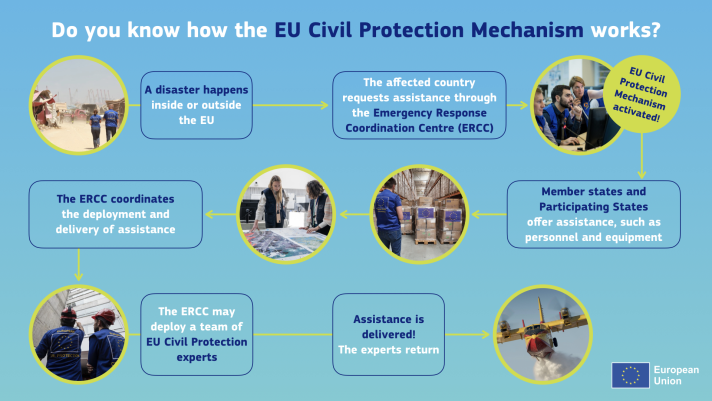EU Civil Protection Mechanism

In October 2001, the European Commission established the EU Civil Protection Mechanism. The Mechanism aims to strengthen cooperation between the EU countries and 10 participating states on civil protection to improve prevention, preparedness, and response to disasters.
When an emergency overwhelms the response capabilities of a country in Europe and beyond, it can request assistance through the Mechanism. The Commission plays a key role in coordinating the disaster response worldwide, contributing up to 75% of the transport and/or operational costs of deployments.
Why is this important?
A joint approach further helps pool expertise and capacities of first responders, avoids duplication of relief efforts, and ensures that assistance meets the needs of those affected.
Pooling together civil protection capacities and capabilities allows for a stronger and more coherent collective response.
In addition to the EU countries, there are currently 10 participating states in the Mechanism (Albania, Bosnia and Herzegovina, Iceland, Moldova, Montenegro, North Macedonia, Norway, Serbia, Türkiye, and Ukraine).
Since its inception in 2001, the EU Civil Protection Mechanism has responded to over 700 requests for assistance inside and outside the EU.
The Mechanism also helps coordinate disaster preparedness and prevention activities of national authorities and contributes to the exchange of best practices. This facilitates the continuous development of higher common standards enabling teams to understand different approaches better and work interchangeably when a disaster strikes.
How are we helping?
Following a request for assistance through the Mechanism, the Emergency Response Coordination Centre (ERCC) mobilises assistance or expertise.
The ERCC monitors events around the globe 24/7 and ensures rapid deployment of emergency support through a direct link with national civil protection authorities.
Specialised teams and equipment, such as firefighting planes, search and rescue and medical teams, can be mobilised at short notice for deployments inside and outside of Europe.

Satellite maps produced by the Copernicus Emergency Management Service also support civil protection operations. Copernicus provides timely and precise geospatial information useful for delineating affected areas and planning disaster relief operations.
In developing countries, civil protection assistance typically goes hand in hand with EU humanitarian aid. Experts in both fields work closely together to ensure the most coherent analysis and response, particularly in response to complex emergencies.
The Mechanism also intervenes in marine pollution emergencies. The ERCC can quickly mobilise oil recovery capacity and expertise from the participating states and the European Maritime Safety Agency (EMSA).
EU civil protection in action
Any country in the world, but also the United Nations and its agencies or a relevant international organisation, can call on the EU Civil Protection Mechanism for help.
In 2022, the Mechanism was activated 106 times to respond to (i) war in Ukraine; (ii) wildfires in Europe; (iii) COVID-19 in Europe and worldwide; and (iv) floods in Pakistan.
Additionally, Member States and participating states can also activate the Mechanism to seek assistance for consular support to their citizens (e.g., in the context of evacuation operations).
Read more on the EU Civil Protection Mechanism website
Source / Website
Related information
- EU Civil Protection Mechanism support to consular assistance
- Emergency Response Coordination Centre (ERCC)
- Disaster Risk Management
- European Medical Corps
- rescEU
- European Civil Protection pool
- Information Day on Civil Protection
- Legal framework